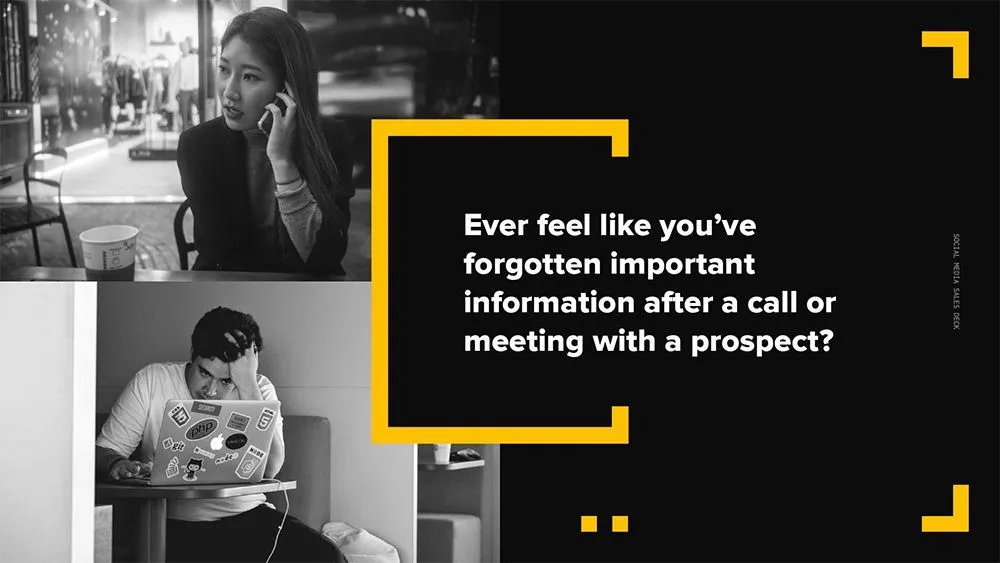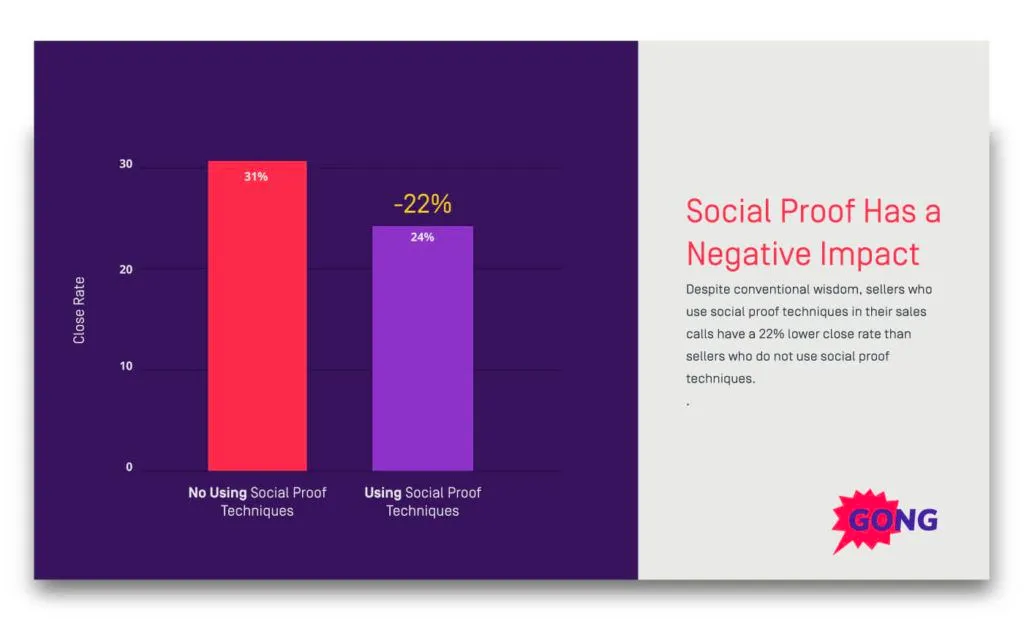
What makes a sales presentation truly effective?
Is it that secret-sauce font, the comprehensive case studies, intricate graphs, or your shining personality? Or is it… something else?
It might seem like a simple question, but understanding the answer unlocks a world of opportunities for sales reps.
If your sales presentations are truly effective, they should accomplish these 4 things:
- Give prospects confidence in your brand
- Develop a deep relationship and mutual understanding of needs and priorities
- Convince potential customers of the value of your product
- Give clear direction for the next conversation
How many of your recent sales meetings have fallen short of these results?
A study by Forrester of more than 300 C-level buyers found that many reps are lacking key information for a successful sales meeting:
 |
Put simply, most salespeople go into meetings:
- Unprepared for questions
- Without knowledge of the business or industry they’re selling to
- Without understanding the prospect’s situation and problems
- Without relevant social proof
Ouch.
Want to avoid falling into the trap of generic, ineffective sales presentations?
While preparing for and delivering a really good sales presentation isn’t an exact science, the following best practices will lead you to better results.
Let’s dive into the top methods sales professionals are using to nail their presentations and deliver killer sales pitches.
How to Prepare the Perfect Sales Pitch Presentation
Think you can get away with giving a great sales presentation on the fly? Think again. A PowerPoint presentation that was thrown together over lunch is not going to impress your decision-makers.
Preparation is a key aspect of every effective sales presentation.
Here are five ways you can prepare for success:
1. Set a Clear Agenda
Your sales presentation is built to guide the conversation and gives you a structure to work with throughout the meeting. But the prospect doesn’t know how your presentation is structured.
Does this situation sound familiar?
Prospect: “This is really interesting, but how does your product solve XYZ?”
You: “Actually, we’ll talk about that in a few slides. Anyway, as I was saying…”
These kinds of interruptions are common, and the popular response of “We’ll get to that” doesn’t normally go over very well with prospects.
Here’s how to avoid this: Set a clear agenda for the conversation, and share that with your prospects.
This could mean sharing an outline of the presentation topics you’ve prepared, or it can mean sharing the whole sales presentation with your prospect.
This way, your prospect can review the information before your meeting, see where you’ll cover certain topics, and save their questions for the right moment.
2. Adapt Your Script and Presentation
Above, we saw that 77 percent of reps enter meetings without a clear understanding of the issues that their prospect is facing, or areas where they can help.
There are two clear ways to fix this problem:
First, do your homework. The more you know about your potential client's business and current situation, the better. Also, try to understand their industry and target audience, read up on current news in the sector, and get a feel for the particular pain points this person is likely feeling the most.
Second, base your presentation and accompanying sales script on your ideal customer profile. If your sales team has multiple ideal customer profiles to sell to, discover which profile this prospect fits into and base your arguments, questions, and main points on the specific needs of this profile.
3. Pick Three Main Points for Each Prospect
No matter how many crazy statistics and fun features you throw at your prospect, they’re still only human. Shocking, we know.
In other words, they’ll probably forget at least half of what you say.
To create effective sales presentations that your prospects will remember, focus on three main bullet points that you want to highlight.
This isn’t a number we pulled from a hat. It’s based on an experiment performed by Kurt A. Carlson and Suzanne B. Shu. Their study found that, when your audience knows you’re trying to persuade them, the ideal number of positive claims to make is three. After four claims, your audience will start to become more and more skeptical of anything you say.
The title of their paper is a catchy phrase to help you remember this principle: Three Charms but Four Alarms.
So, go through your slides and pick three key points that you want your prospect to remember. Maybe these will be product features or maybe not, but once again, base these points on the real, felt needs of your prospect. You’ll see better results.
During the presentation, draw your audience's attention to these points as you introduce new ideas. Phrases like these draw attention at the right moments:
- Here’s the point…
- This is crucial…
- But this is what matters…
- But it gets even better...
- This next point is really important...
- This is what XYZ could mean for you, Jack…
And make sure these key points lead directly where you want them to—to your call to action. If they aren’t leading you to that, what’s the point?
For more, check out this video, where I talked in-depth about captivating and directing your prospect's attention during a sales conversation. Remember: whether you're delivering in-person or via video conferencing, maintaining eye contact and using body language to draw attention to main points works.
4. Use Visuals to Show, Not Tell
A sales deck can have several different functions. For example, if your sales deck is going to be read and discussed among stakeholders at your prospect’s company, it will need to include text that explains the visuals presented.
However, if you’re giving a sales presentation with that deck, it doesn’t need all that text.
To prepare a sales presentation for a product or service, make sure you include infographics and visuals that complement what you’re saying. You can use Canva or even a responsive whiteboard to do this.
Think of your slides as visual aids that give more meaning and context to your words.
These visuals can help to:
- Simplify complex processes
- Provide a clearer understanding of data/metrics
- Add credence to your words
- Keep your audience engaged
- Help your audience remember main points (this one is backed by science)
In short, for an effective sales presentation, keep your script and your slides separate. Use your words to add meaning to the visuals, and use your visuals to maximize the power of your words. With this approach, you will elevate your value proposition—and increase your close rate.
5. Show Them You Know Their Pain
Using a narrative in your presentation shows that you’re sympathetic to the problems your prospects are facing and that you know how to solve them.
So, what’s the narrative for your product?
Generally, the story you tell with your presentation will follow this pattern:
- There is a problem caused by a shift in the market, a change in the company’s circumstances, or the world situation
- That problem is solved, the business is saved, and your product is the hero
A compelling narrative that captures the feelings and frustrations of your prospect shows them that you understand them, you’re on the same page, and you’re here to help.
 |
Maybe this is the story of how your product was born, to solve a problem internally at your own company. Maybe it’s the story of one of your successful customers. Or maybe it’s just a narrative that they can relate to and see themselves in.
 |
In any case, using stories instead of just facts makes your presentation more memorable. According to one study, people only retain about 5-10 percent of the statistical information they hear. But they’ll remember 65-70 percent of the information they hear as stories.
Take advantage of this fact: Turn your data into a narrative.
Once you’ve prepared your sales deck and accompanying script, you’re ready to nail your next sales presentation.
Or are you?
Day-Of Sales Presentation Tips: Nail Your Next Sales Presentation
Ready for the big day? Here are six more tips you can use while actively presenting to your prospect, to give a truly effective sales presentation.
6. Open With Your Biggest Selling Point (Don’t Save it for the End)
Many sales reps like to save their product’s biggest selling point for the very end of their presentation, as if they’re coming to some grand crescendo.
But your prospect didn’t come to this meeting hoping to hear the Philharmonic Orchestra play Beethoven’s Symphony No. 5. So, don’t play this pitch deck like another day at the theater.
Instead, open with your big selling points. Dazzle your prospects from the get-go, and you’ll have them hooked to the end.
To be counted among the Sales Success Stories and Stars of your organization… just go for it. Get the show on the road with a big opening. Leave them in (happy) tears.
7. Ask Open-Ended Questions
To understand your prospects and to keep them engaged with your presentation, questions are essential.
But wait, if you’re giving a sales presentation, aren’t you the one that’s supposed to be doing the talking? You answer the questions, right?
True. But, how do you know if your prospect is paying attention? How can you highlight the relevant points in your presentation if you don’t know what interests them?
To engage your prospect and draw them into your presentation, ask questions like:
- Can you walk me through how your team handles [problem]?
- Have you found any clever workarounds for when [issue] happens?
- What would your ideal solution to this problem look like?
- How would you expect a solution to this problem to affect your team?
It’s true; you’ve probably asked a lot of similar questions during the qualifying stage. But with these questions, you can lead the conversation and keep your prospect engaged with what you’re saying.
Open-ended questions will also help you with the next tip:
8. Build Context Around Your Biggest Value Points and Differentiators
The same questions we shared above can help add context to what you’re saying.
Don’t just tell the prospect: “Our product helps you solve X problem.”
Add meaning to that value point by asking questions:
- How often do you face X problem?
- How much time/money do you lose when this happens?
- How does X problem affect the morale/productivity of your team?
When you have the numbers clear, reiterate the problem: “So, you lose $X every week because of this problem. That’s more than $Y per year that’s going down the drain until you solve this issue.”
Then, bring in your value point: “With our product, you could save $Z every year by eliminating this problem for your team.”
The same method works for highlighting your key differentiators.
Instead of telling prospects that your product is the best because it’s the only one that does X, lead prospects to the features and benefits that set your product apart with open-ended questions.
This creates value and context around a problem that only your product can solve.
9. Make Social Proof Engaging: Mirror the Prospect’s Situation
This data blew our minds and will probably blow yours, too: According to studies from our friends at Gong, sellers who use social proof in their sales calls have a 22 percent lower close rate.
 |
Have you noticed a similar pattern with social proof in your sales presentations?
We all know that social proof is a powerful tool in the hands of sales reps and marketers. No need to throw out all your social media customer quotes or company testimonials. But, it must be used correctly to work effectively.
Otherwise, you could actually hurt your chances of closing.
So, what’s the correct way to use social proof in your presentations?
Favor customers that are part of this prospect’s tribe.
For example, imagine you’re selling to an SMB, and you tell them that Facebook is your customer. They’ll be impressed, sure… but they’ll also start to wonder if your product is really a good fit for their small business.
Instead, when selling to SMBs, talk about your other SMB customers. Use examples of happy customers who are in the same field or industry. Or, find customer stories that mirror this prospect—with similar pain points.
With tribal social proof, you’ll gain the respect of prospects while demonstrating that you truly “get” them.
10. Never Talk Price Before Value
Chances are, you’re talking price somewhere in this sales presentation. At this stage in the sales pipeline, it’s normal that your prospect is ready to hear what your solution will cost.
But don’t open the conversation like this.
Sometimes, you get into a room (whether in-person or virtual) with your main point of contact and important stakeholders, and the first thing they want to know is: “How much will this cost us?”
One of the golden rules of sales is this: Never talk price before value.
If you fold to the pressure and start off by talking about the price of your solution, your audience will view your product as a commodity, not as a valuable solution to their problem.
When stakeholders push you for a number, don’t be afraid to push back. If they’re insistent, turn the question back around on them:
“Before we talk about price, let me ask you this: How much will it cost your company if you don’t get these issues solved by next quarter?”
By focusing on the real monetary value that your product provides, you’ll help position your product as a premium solution, not a wholesale band-aid.
11. Keep It Less Than 10 Minutes
Did you know that every presenter at Apple’s product launches speaks for just 10 minutes or less?
This is because science tells us that the brain gets bored easily—our attention spans just can’t expand beyond a certain point. However, you can reengage your audience by introducing a change every 10 minutes.
Apply this principle to your keynote sales presentations: If you’re presenting longer than 10 minutes, the prospect’s interest will steadily decline. Wrap it up.
Our friends at Gong found that there’s a sweet spot for winning sales presentations: 9.1 minutes. It’s like the ideal elevator pitch for sales presentations.
 |
So, stick to this rule of thumb: Keep your presentations under 10 minutes.
Sales Presentation Templates: Use These Sales Pitch Decks to Win More Deals
Want to build a stellar sales pitch presentation? Steal these presentation templates and customize them to your business—including stunning visuals, striking text, and a presentation process that wins deals.
Get the Powerpoint or Keynote version of these templates, and start creating your own effective sales presentations!
Ready to Give the Best Sales Presentation Ever?
You’ve got all the pro tips you need to nail your next presentation.
In the end, you want to demonstrate that you understand your prospect’s needs and concerns. Show you “get” them by adding a compelling narrative and including customer stories that mirror their own situation.
An effective presentation must also be engaging, which is why it’s essential to highlight three main points and add context with open-ended questions.
With this info, you’re ready to deliver a winning sales presentation. (Psst... don't forget to use our sales presentation templates to get started!)
But what happens next? There are still some unaccounted-for areas of the sales process. If you want to really crush the follow-up and close more deals, you need a CRM to help you do it.
Close CRM does all this—and so much more. Watch our demo or try Close free for 14 days.










